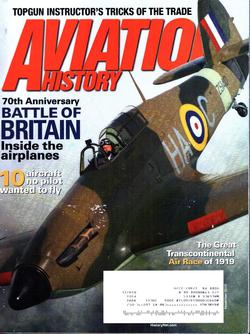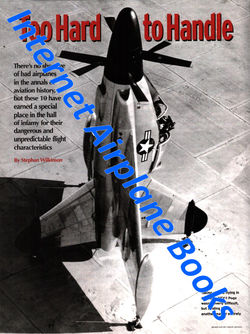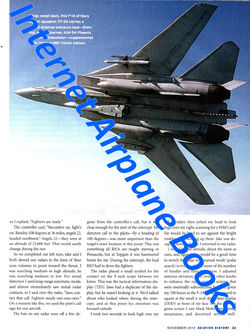AVIATION HISTORY NOV 10 TOP GUN F-14_XF-84H_HAWKER
HURRICANE_TRAVEL AIR 2000
WW2 RAF FIGHTER
COMMAND HAWKER HURRICANE
US NAVY TOP GUN
INSTRUCTOR TRICKS OF THE TRADE – GRUMMAN F-14 TOMCAT VF USN
WW2 BOEING B-29
SUPERFORTRESS CREW INTERNED IN SOVIET SIBERIA
TRAVEL AIR 2000
REPUBLIC XF-84H
THUNDERSCREECH
“STAPME”
STAPLETON BECAME AN RAF ACE IN THE BATTLE OF BRITAIN
BOEING B-17E
FLYING FORTRESS “SWAMP GHOST” COME HOMES FROM PAPUA NEW GUNIEA
WW2
CONSOLIDATED B-24 LIBERATOR DISCOVERED BY DIVERS OFF THE COAST OF CROATIA
70TH
ANNIVERSARY OF THE BATTLE OF BRITAIN
10 AIRCRAFT
THAT NO PILOT WANTED TO FLY (DE BRUYERE C.1, TARRANT TABOR, CURTISS SO3C
SEAMEW, JUNKERS Ju322, AVRO TUDOR, SHORT SEAMEW SB.6, CONVAIR XFY-1 POGO,
ROLLS-ROYCE FLYING BEDSTEAD, TUPOLEV Tu22 BLINDER)
THE GREAT TRANSCONTINENTAL
AIR RACE OF 1919
------------------------------------------------------------------------------------------
Additional Information from
Internet Encyclopedia
The Republic XF-84H
"Thunderscreech" was an experimental turboprop aircraft derived from
the F-84F Thunderstreak. Powered by a turbine engine that was mated to a
supersonic propeller, the XF-84H had the potential of setting the unofficial
air speed record for propeller-driven aircraft, but was unable to overcome aerodynamic
deficiencies and engine reliability problems, resulting in the program's
cancellation.
Although the USAF Wright
Air Development Center was the key sponsor of the Republic Project 3347
turboprop fighter, the initial inception came from a U.S. Navy requirement for
a carrier fighter not requiring catapult assistance.[2] Originally known as
XF-106 (a designation later reused for the Convair F-106),[3] the project and
its resultant prototype aircraft were redesignated XF-84H,[4] closely
identifying the program as an F-84 variant, rather than an entirely new
type.[5] With a projected contract for three prototypes, when the US Navy
cancelled its order, ultimately, the remaining XF-84H prototypes became pure
research aircraft built for the Air Force's Propeller Laboratory at
Wright-Patterson AFB to test supersonic propellers in exploring the combination
of propeller responsiveness at jet speeds.
The XF-84H was created by
modifying a F-84F airframe, installing a 5,850 hp (4,360 kW) Allison XT40-A-1
turboprop engine[7] in a centrally-located housing behind the cockpit with a
long extension shaft to the nose-mounted propeller.[8] The turbine engine also
provided thrust through its exhaust; an afterburner which could further
increase power to 7,230 hp (5,390 kW) was installed but never used.[9] Thrust
was adjusted by changing the blade pitch of the 12 ft (3.7 m) diameter
Aeroproducts propeller, consisting of three steel, square-tipped blades turning
at a constant speed, with the tips traveling at approximately Mach 1.18 (1,446
km/h). To counter the propeller's torque and "P-factor", the XF-84H
was fitted with a fixed dorsal yaw vane.[10] The tail was changed to a T-tail
to avoid turbulent airflow over the horizontal stabilizer/elevator surfaces
from propeller wash.
The XF-84H was destabilized
by the powerful torque from the propeller, as well as inherent problems with
supersonic propeller blades.[12] A number of exotic blade configurations were
tested before settling on a final design.[10] Various design features were
intended to counteract the massive torque, including mounting the left leading
edge intake 12 in (30 cm) further forward than the right, and providing left
and right flaps with differential operation.[8] The two prototypes were equally
plagued with engine-related problems affecting other aircraft fitted with T40
engines, such as the Douglas XA2D Skyshark and North American A2J Super Savage
attack aircraft. A notable feature of the design was that the XF-84H was the
first aircraft to carry a retractable/extendable ram air turbine. In the event
of engine failure, it would automatically swing out into the airstream to
provide hydraulic and electrical power. Due to frequent engine problems, as a
precaution, the unit was often deployed in flight.
After manufacture at
Republic's Farmingdale, Long Island, plant, the two XF-84Hs were disassembled
and shipped via rail to Edwards Air Force Base for flight testing.[2] First
flown on July 22, 1955, the XF-84F had incredible acceleration but soon its
impracticality was discovered. It was unsuited to combat due to the engine's 30
minute warm up time but the most serious concerns were vibration generated from
the 12-foot propeller diameter and mechanical failures of the prop pitch
gearing.[13] The prototypes flew a total of 12 test flights from Edwards,
accumulating only 6 hours and 40 minutes of flight time. Lin Hendrix, one of
the Republic test pilots assigned to the program, flew the aircraft once and
refused to ever fly it again, claiming "it never flew over 450 knots (830
km/h) indicated, since at that speed, it developed an unhappy practice of
'snaking', apparently losing longitudinal stability". Hendrix also told
the formidable Republic project engineer, "You aren't big enough and there
aren't enough of you to get me in that thing again". The other test
flights were fraught with engine failures, and persistent hydraulic, nose gear,
and vibration problems. Test pilot Hank Beaird took the XF-84H up 11 times,
with 10 of these flights ending in forced landings.
The XF-84H was almost
certainly the loudest aircraft ever built, earning the nickname
"Thunderscreech" as well as the "Mighty Ear Banger".[16] On
the ground "run ups", the prototypes could reportedly be heard 25
miles (40 km) away.[17] Unlike standard propellers that turn at subsonic
speeds, the outer 24–30 inches (61–76 cm) of the blades on the XF-84H's
propeller traveled faster than the speed of sound even at idle thrust,
producing a continuous visible sonic boom that radiated laterally from the propellers
for hundreds of yards. The shock wave was actually powerful enough to knock a
man down; an unfortunate crew chief who was inside a nearby C-47 was severely
incapacitated during a 30-minute ground run.[17] Coupled with the already
considerable noise from the subsonic aspect of the propeller and the T40's dual
turbine sections, the aircraft was notorious for inducing severe nausea and
headaches among ground crews.[11] In one report, a Republic engineer suffered a
seizure after close range exposure to the shock waves emanating from a
powered-up XF-84H.
The pervasive noise also
severely disrupted operations in the Edwards AFB control tower by risking
vibration damage to sensitive components and forcing air traffic personnel to
communicate with the XF-84H's crew on the flight line by light signals. After
numerous complaints, the Air Force Flight Test Center directed Republic to tow
the aircraft out on Rogers Dry Lake, far from the flight line, before running
up its engine.[14] The test program did not proceed further than the
manufacturer's Phase I proving flights; consequently, no USAF test pilots flew
the XF-84H. With the likelihood that the engine and equipment failures coupled
with the inability to reach design speeds and subsequent instability experienced
were insurmountable problems, the USAF cancelled the program in September 1956.







